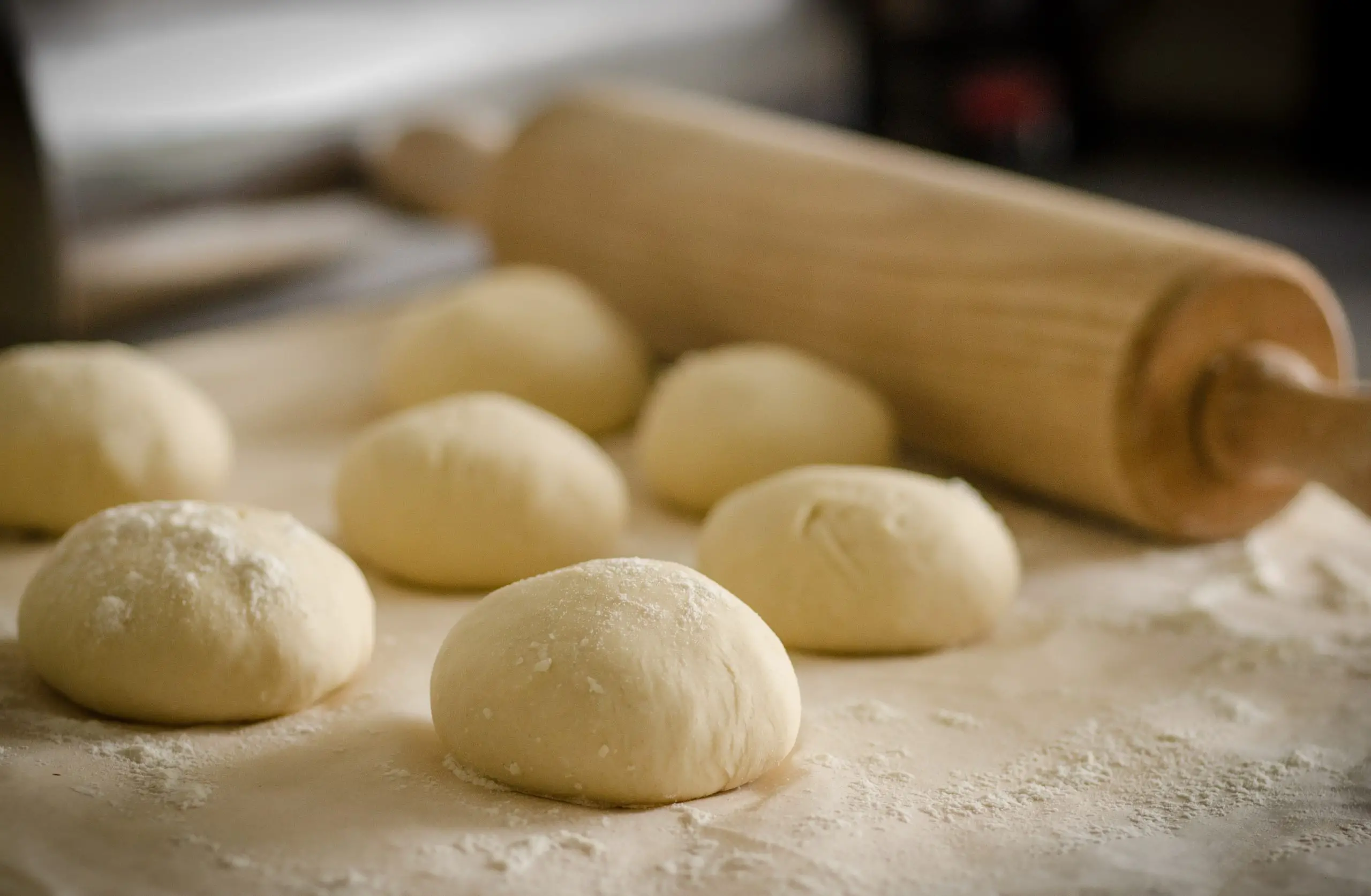If you’re ready to make your pizza dough, you also want to know how to freeze it later. You’ve come to the right place. The first step is to put it in a plastic ziplock bag without holes, or you can put it in a Tupperware container.
Here are two ways to freeze homemade pizza dough: Tupperware containers or freezer-safe zip bags. This article will teach you how to freeze homemade pizza dough, how to thaw frozen pizza dough, how pizza dough spoils, and how long it will keep frozen.

How to Freeze Homemade Pizza Dough?
One of the yeast doughs that freezes nicely is this one. Food can live longer if it is frozen, such as pizza dough. When you’re prepared to cook, just let it defrost. We’ll teach you how to keep pizza dough for future pizza nights or impromptu cravings. Pizza dough can be frozen in any quantity; let it rise completely first, then divide it into sections for individual pizzas before freezing. The dough only has to thaw in the refrigerator overnight before use after being frozen for up to three months.
Follow these steps to freeze pizza dough. The dough should first be divided into sections of the same size. To produce a single pizza, each ball should be large enough. Place the pizza dough in a freezer bag after lightly brushing it with oil (we suggest olive oil) on all sides. Before putting the container in the freezer, ensure all the air is pushed out. For three months, the dough can be stored in the freezer. The date should be put on each bag. Here’s how to do it:
1. Using Freezer Bag or a Ziplock Bag
The dough should be placed in a deep, oiled baking pan with room to expand, covered with plastic wrap, and chilled overnight for cold fermentation before being frozen for 24 hours. Transfer each piece of frozen pizza dough into a separate freezer zip bag or food saver bag.
2. Using Tupperware Containers:
Your Tupperware containers’ edges and bottom should be lightly oiled. Pizza dough should be placed in the containers, covered, and chilled overnight to allow for cold fermentation (there is no need to transfer it later), after which the containers should be moved to the freezer.
How do you Thaw Frozen Pizza Dough?
Place the dough in the refrigerator for 8 to 12 hours. After about 30 minutes of letting it warm up on the counter, start stretching it. Pizza dough can be quickly defrosted in a bowl of cold water if you’re short on time. Be careful to replace the water every 30 minutes and keep the dough wrapped in plastic.
Using Parchment Paper to Speed Up the Thawing
Using parchment paper to speed up thinning homemade pizza dough is an excellent idea, but there are some disadvantages. Pizzas prepared on parchment paper may not be as crispy as those prepared on a baking stone or pizza pan.
The crispy crust depends on direct contact between the pizza and the baking surface. When using parchment paper, It is preferable to only apply it to the bases of the pizza rather than the top or sides. Place the frozen pizza dough on a baking sheet prepared with Silpat mats or parchment paper to enhance the thawing process.
Place the dough in the oven for about 10 to 12 minutes. Wait for the dough to rise, and then follow the recipe. This method works well for defrosting homemade pizza dough, but it requires close monitoring, and the oven’s temperature should be monitored carefully. Once the dough is thawed, you can bake it as usual.
Is it Safe to Refreeze Frozen Pizza Dough After Thawing?
No, it’s not safe to refreeze frozen pizza dough after thawing. There are several reasons why you should never refreeze frozen pizza dough after thawing. The first is that thawing it will allow for bacteria and infection growth. You may end up with soggy pizza instead. Another reason is that it may be partially baked when you refreeze it.
This is especially true if you refreeze your Stouffer’s French Bread Pizza. When the dough is in the freezer, it contains the yeasts that make it rise. When they come to room temperature, they quickly reactivate. Once reactivated, the yeasts will convert sugars in the dough into alcohol and carbon dioxide. This process is called fermentation.
The dough will develop a sour taste and coarse texture if it continues for too long. Avoid prolonged room temperature exposure if you refreeze frozen pizza dough after thawing it. If you want the dough to rise completely immediately, you can freeze it individually. You can even buy pizza dough in freezer bags.
Make sure you label them to identify which is which easily. You can use olive oil, baking spray, or your favorite cooking oil to make it easier to pull out. Be sure you have the appropriate amount of pizza dough on hand. If you refreeze frozen pizza dough after thawing, you can refreeze each ball individually.
How Long can Homemade Pizza Dough Keep in the Fridge?
Homemade pizza dough can be stored properly for a maximum of five days in the refrigerator or three months in the freezer. The amount of yeast in the dough will determine the ideal storage period. Pizza dough can be held in the freezer for up to three months. If vacuum-sealed, it can last for up to four months.
Can Fermentation Enhance the Flavor of Homemade Pizza Dough?
The longer the dough ferments, the better the flavor. Fermentation also develops gluten. Short fermentation causes the dough to tear as you stretch it. Fermentation should last from three to five days. The fermented dough should be lively and bubbly and double in size. Refrain from overworking the dough during the second rising, as this can cause the bubbles to pop and the crust to harden.
When fermenting dough at low temperatures, yeast produces fewer acids and gasses, so the cold-fermented dough has a subtle tanginess. The fermented dough is easier to work with and has a tangy flavor. The cold-fermented dough requires less yeast than traditional dough recipes, as the rising process is slow. Use only good-quality sea salt. Make sure to check the recipe’s instructions before adding yeast.
What’s the Best Way to Keep Pizza Dough at Room Temperature?
Pizza dough should be kept in an airtight container or wrapped in plastic to prevent odors. The dough won’t dry out and form a hard, dry surface if you do that. Brushing olive oil on the dough and container is another smart move. Additionally, it will be easier to remove from the container when making pizza, which will prevent the surface from drying up.
It would be best to double or quadruple your recipe when preparing pizza dough, but Experts suggest making one large batch first. Then, as previously mentioned, allow it for 1-2 hours in an oiled container. Initially, form smaller, portion-sized dough balls. Afterward, depending on the type of pizza dough you’re creating, allow it for another hour to overnight.
Why does Pizza Dough Spoil?
Over-proofing is a major threat. Overproofing occurs when you give the dough too much time to rest; as a result, the gluten is no longer able to hold the gases inside the dough in place, and the dough begins to lose its shape and texture. Pizza dough’s surface is not airtight, like a balloon that holds all the gas inside, so gas is continually escaping.
The dough will continue to rise as long as the yeast can produce enough gas. However, if you leave the dough to rest for an excessive amount of time, the gluten fibers will weaken, and the yeast won’t be able to produce enough gas to keep the dough rising. You would then have a dough that lacks structure and cannot maintain its shape.
Pizza dough will go alright because it becomes unsafe to consume merely by being left out for a while. Providing your ingredients aren’t faulty, tainted, moldy, etc. Therefore, it is crucial to make pizza with high-quality ingredients. If the dough is left out too long, it could develop unpleasant flavors.
How to Prevent Freezer Burn?
Foods should be properly wrapped or packaged before being frozen, and your freezer should maintain a cool enough temperature to prevent freezer burn. Utilizing your frozen meals quickly to avoid having anything sit in storage for an extended period is the greatest method to avoid poor quality.
Using wax paper or parchment paper to prevent freezer burn
Every time you make your pizza dough, you should use a layer of parchment or wax paper to prevent freezer burn. While these two layers can be used for other uses, wax paper is specifically designed to store food.
This paper is nonstick and moisture-resistant, making it ideal for sandwiches and other food items. Parchment paper, on the other hand, contains silicone, which prevents it from burning or melting in the oven. The same can be said for storing meats or produce.
Freezer paper is made from silicone or waxed paper. It is thick and can seal in juices. Once wrapped, place it in a freezer-safe bag and remove as much air as possible. This will prevent freezer burn and drying out the meat. It is also safe to use a microwave cover made of wax paper.
Conclusion
The best option for home cooks to store leftover dough is to freeze homemade pizza dough. Use this step-by-step guide to freeze pizza dough for your upcoming pizza night. Consider a few practical suggestions to maintain the freshness of frozen pizza dough—plastic wrap the dough to hasten the storing procedure. Do not use parchment paper. In the refrigerator, defrost your pizza dough.
Separately store your preferred toppings. Individual freezer bags can store extra toppings like sun-dried tomatoes and pesto sauce. While some other meat toppings, like sausage, only have a three-month freezer shelf life, pepperoni may be kept for up to six months. To keep track of upcoming expiration dates, clearly write the date on the freezer bags.

